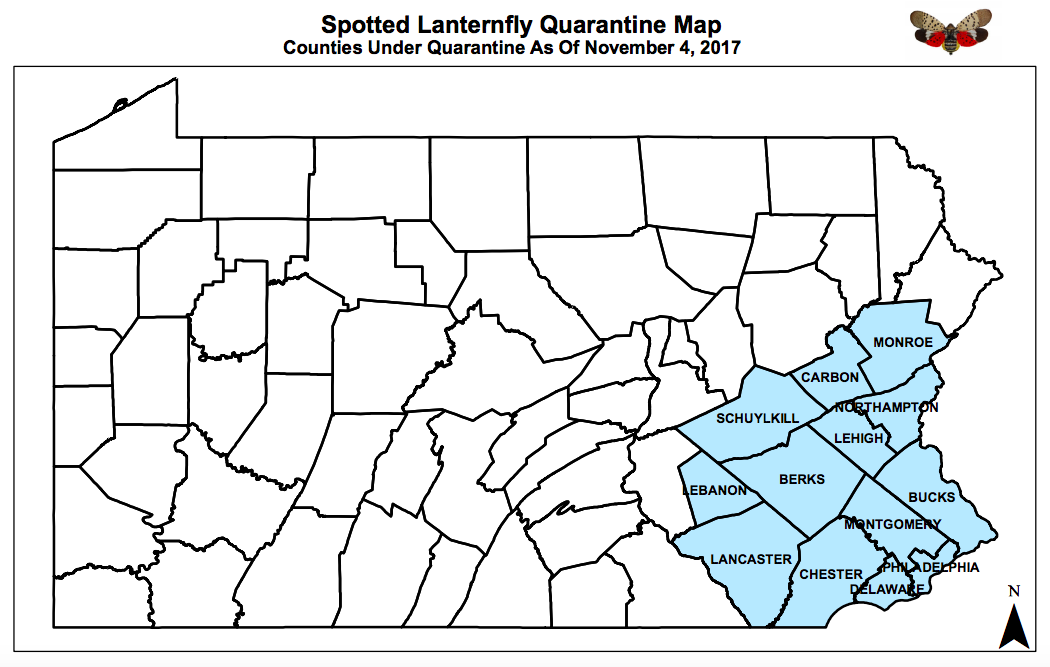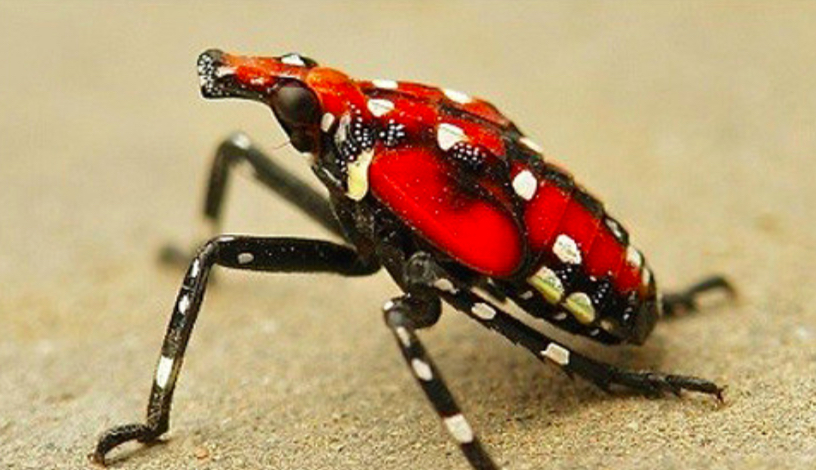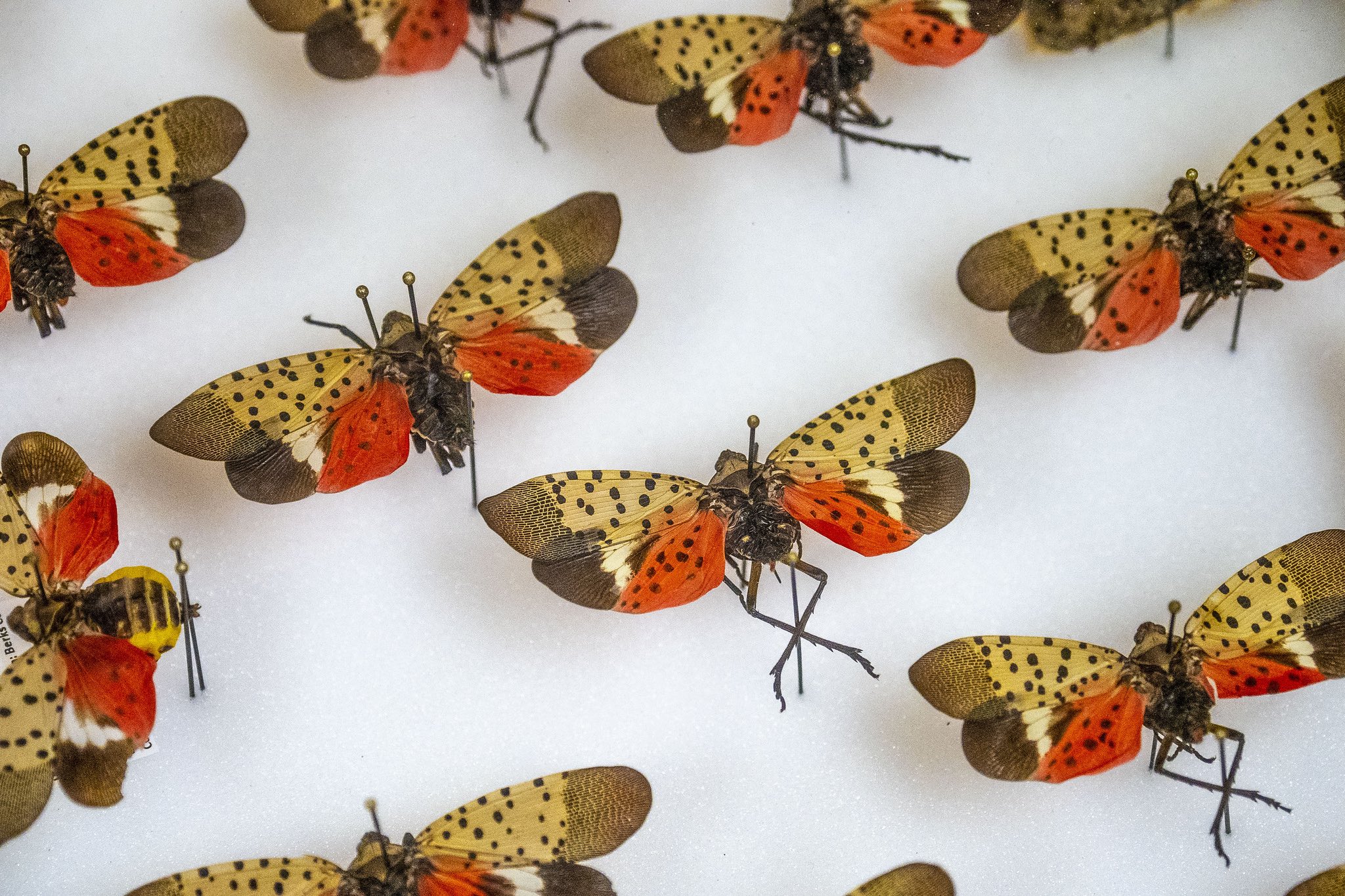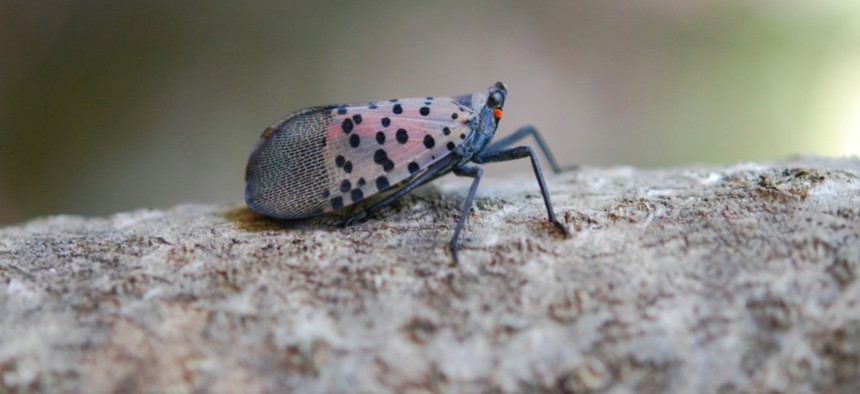Connecting state and local government leaders
Southeastern Pennsylvania is ground zero for an invasive species outbreak that’s threatening trees and crops. Can it be contained?
When spotted lanternflies descended on Calvin Beekman’s property last year in Berks County, Pennsylvania, he says they came by the thousands.
“It looked like a locust plague, just overtaking you” said Beekman, who owns about 80 acres of apple trees and 42 acres of wine grapes on land his family has farmed for four generations.
Insecticides killed the pests. But, as they died, more arrived from the surrounding woodlands. At one point, he said he counted 320 dead lanternflies under one grape plant, killed by a single round of spraying, while on the plant another 40 or 50 were still feeding.
Beekman’s apple orchard was largely spared from the destruction the insects caused. His grapes were not. In a normal year, he said his vineyard yields about 140 tons of grapes, which are used to make wines like cabernet sauvignon and cabernet franc.
Last year, he harvested 62 tons, losing an estimated $100,000. This year he expects just 4 tons at best.
In addition to sucking the life out of the grapes, the lanternflies consumed nutrients their vines depend on, weakening some to the point where Beekman said they did not survive last winter. Other plants that weathered the cold months didn’t grow properly, some with stunted shoots.
Beekman said he’s now removing dead blocks of grape vines on his vineyard, but holding off on replanting until he has a better understanding of what will happen next with the lanternfly. It takes about $20,000 per acre and four years of time to get wine grape plants into production, he said.
“My vineyard was a show place,” Beekman said. “If you would see it now, it’s a disaster.”
An invasive pest
Beekman’s property is near the epicenter of a spotted lanternfly outbreak that has bedeviled parts of southeastern Pennsylvania in recent years. In addition to the risks to grapes, the insect is considered to be a threat to fruit trees, hops and hardwood timber.
Earlier this year, the U.S. Department of Agriculture put forward $17.5 million to help combat the lanternfly in Pennsylvania. This money was in addition to state funds of $3 million in the most recent budget. In prior years, government spending to fight the pest in Pennsylvania was in the ballpark of $1.2 million.
“The funding was not keeping up with the insect,” said Fred Strathmeyer, deputy secretary for consumer protection with the Pennsylvania Department of Agriculture, when asked why the significant infusion of federal money became necessary.
The spotted lanternfly is native to Asian countries such as China, India, and Vietnam.
In the U.S., the first sighting was in Pennsylvania in 2014, when a game commission officer there came across one in his backyard and brought it to state authorities. Researchers believe the insects had probably been around for at least two years by the time of the first sighting.
Ruth Welliver, director of the state agriculture department’s plant industry bureau, said the state is pretty sure that the lanternfly gained access to the U.S. by attaching itself to products imported from Asia, slipping past inspectors who weren’t yet on the lookout for it.
“This insect wasn’t really on anyone’s radar,” she said.
There are now 13 Pennsylvania counties, including the one that encompasses Philadelphia, inside a quarantine zone, where the bug is known to be present.

Since appearing in Pennsylvania, lanternflies have turned up in pockets of other states, including Delaware, New Jersey and Maryland. But they have not established thriving populations in those places. A single dead individual lanternfly recently appeared in New York.
Julie Urban, a professor at Pennsylvania State University and a leading lanternfly researcher, pointed out that the spotted lanternfly is different from other destructive pests, like the emerald ash borer, because it is less particular about the types of plants it feeds on, raising the possibility that it could hurt a wide range of species.
“That’s why this is so scary,” she said.
Urban and others are in the process now of trying to assemble the first estimates of what level of damage the lanternfly has caused in Pennsylvania. There are currently other anecdotal reports, similar to what Beekman described, of harm to grapes and vines not overwintering. It’s also possible the insect can kill hops plants in just one year, Urban said.
Adult spotted lanternflies are about 1 inch long and a half-inch wide. The insects look different as they age. Young ones are mostly black or red with white spots. Adults take on a light brownish coloring, with black spots, and red that is exposed on their wings when they fly.

The lanternfly doesn’t bite people, or carry human diseases. They damage plants and trees by sucking sap from stems and leaves. This can harm photosynthesis, weaken the plant and cause it to ooze or weep, according to a USDA “pest alert” describing the bug.
As they digest their food, spotted lanternflies themselves excrete fluid called “honeydew," which can coat surfaces and cause mold growth, including on fruit. It also attracts other insects.
Lanternflies are not very good fliers. But they are crafty hitchhikers and females can lay their eggs inconspicuously in places like the underside of a railcar, or on a shipping pallet.
“The egg masses look like a smudge of mud, it’s almost impossible to see them,” Welliver said.
The economic stakes could become high in Pennsylvania if hardwood forests there are threatened by the bug. Brian Rider, executive director of the Pennsylvania Forest Products Association, noted that the state is the largest producer of hardwood lumber in the country.
“It’s in excess of a $17 billion a year business in Pennsylvania,” he said.
Lanternflies are known to feed on oak and walnut. The state agriculture department has received reports of “yellowing and weakening” of some trees, particularly walnut. But much of the logging in Pennsylvania is in northern and northwestern parts of the state, away from the current infestations.
Beyond threatening agriculture and adding costs for businesses, the insects are proving to be a quality of life issue, said Strathmeyer. In infested areas there can be hundreds of thousands. “You’re killing hundreds,” he said. “But hundreds keep coming.”
Urban described conditions in Redding where lanternflies were not swarming, but could be found on park banisters, ledges and covering tree branches. She said if you were to stand under an infested tree, where the bugs are dripping honeydew, “it’s like you’re being rained on.”
Control efforts
Spotted lanternflies have an especially strong appetite for a fast-growing tree known as “tree-of-heaven,” or Ailanthus altissima, which is native to a region that extends from China to Australia, but is invasive in the U.S. The insects’ attraction to the tree offers options for killing them that have become central to Pennsylvania’s program to control the pest.
Strathmeyer describes the strategy as “hack-and-squirt.”
Ailanthus trees are cut down with the goal of reaching a targeted amount per acre. Those left standing are loaded up with insecticide. “You turn them into the bait,” Welliver said. When lanternflies come to feed on the bait trees they are poisoned.
One of the reasons this program works, Welliver explained, is that Ailanthus is a “junk tree,” and that “nobody uses it for anything, including other insects and wildlife.”
She said this approach is showing results. “As we expand the amount of area, the region, where we are doing that kind of control,” Welliver added, “we’re very, very hopeful that we will crash the population. And, in the meantime, we’re doing research to say, ‘well, will that take care of it completely, or do we need to add some other tools?'”
Urban said the fact that the insect has stayed in a relatively confined area since it first appeared shows it is possible to contain, but its ability as a hitchhiker is dangerous. With the added federal support in place, she sees this year as a pivotal point in the battle against the bug.
The hack-and-squirt method, she said, can be efficient and effective. But it has limits.
Homeowners and farmers are looking for cost effective ways to protect crops, trees, and plants. Researchers are currently trying to determine the safest ways for them to do this, while limiting the use of poisonous substances. “You can’t nuke everything,” Urban said.
Frustrations
Beekman recognizes that state authorities are working to combat the spotted lanternfly, “doing what they can,” and that there’s been progress on some fronts. He was complimentary of the Penn State experts who he says have set-up a makeshift research lab in his office.
But he expressed doubts about whether the insect can ultimately be killed off, and frustrations over some of the ways the state has handled the response. When the bugs first appeared in 2014 and 2015, he said they were in an area he estimated to be about a half-mile circle.
Because the space was confined, he and other fruit growers recommended to “just spray it and take care of it.” But the state agriculture department, Beekman said, declined to back this plan.
When asked about this, Shannon Powers, a department spokesperson, said in an email response that, “we already know that blanketing an area with insecticide would endanger badly needed pollinators, as well as people, animals, other commodities, and the area ecosystem.”
Beyond the origins of the state response, Beekman feels the state agriculture department hasn’t done enough to communicate with him about what’s happened on his farm. He also voiced complaints about the slow pace of some local-level efforts to cull Ailanthus trees, and he’s skeptical of measures to prevent the insects from hitching rides.
“There’s trains that run right through here,” he said, “probably 20, 30 trains a day, traveling with freight.” Beekman added: “You and I both know that they’re not checking that train.”
Powers said that the state is taking a “team approach” to dealing with the lanternfly and that Penn State is one of the key team members. “Our strategy of assigning different roles to each team member, rather than duplicating efforts, may mean an orchard owner may work with one member of the team rather than the whole team,” she added.
She also acknowledged that it’s a “daunting task” to get travelers and transport companies to cooperate with best practices for preventing the spread of the insect. “But we are using every method at our disposal to do so,” she said, noting that businesses have been “extremely responsive” to the quarantine restrictions.
Powers said social media, particularly Facebook, has been especially effective spreading the word about the spotted lanternfly and the threats it poses. Messaging around the risks to hops and, in turn, craft beer have been especially resonant, she said.
There’s also a “Look Before You Leave” campaign that encourages people to check their clothing and vehicles when traveling out of the quarantine area. And there’s a required state training and permitting program in place for certain businesses, like trucking firms.
Weaver’s Orchard
Ed Weaver says this year is the first he’s seen large numbers of spotted lanternflies on his farm, Weaver’s Orchard, which is also located in Berks County. The farm was started by his grandparents in the 1930s. Weaver grows apples, as well as other fruits like peaches and berries.
He said he got rid of many of the trees of heaven that were on his land, but left some on the perimeter, along the edge of the surrounding woods, which he doctors with pesticide. All of this and other work to control the insects takes time, money and equipment, he noted.
“The thing that I am seeing is that, now that they’ve become adults, they are starting to roam around more, looking for more food,” Weaver said.
While they won’t attack apples themselves, they will go after other parts of the trees and their sticky excrement can drip all over the fruit. “That’s a prime environment for disease,” Weaver explained, describing how the fruit can become coated in mold that turns black.
Although his orchard is not certified as organic, Weaver said he tries to avoid synthetic pesticides as much as possible. But with lanternflies, he said he has no other choice, for now at least, to ward them off.
He’s worried about younger trees and how their development will be affected if the insects feed on them.
And he’s worried about his customers. Weaver’s Orchard does a sizable amount of direct-to-consumer sales. People go there to buy produce, pick their own fruit and for events.
Weaver says he’s heard stories about lanternflies getting so bad is “that it’s just miserable being outside.”
“Will the numbers be that high that people will not have an enjoyable experience here?” he said. “There’s a lot of unknown.”
‘Winnable battle’
Last week, Timothy Newcamp, state plant health director in Pennsylvania for USDA’s Animal and Plant Health Inspection Service, said at a press conference that the agency has this year opened four field offices in the state, which are working on lanternfly response.
When they’re fully staffed, the agency will have 96 employees available to work on the efforts.

“Control teams” and surveillance staff from USDA are concentrating on an 18-mile buffer zone that surrounds the quarantine area. Since April, Newcamp said teams had treated 15 properties, with over 1,900 acres as part of control efforts, relying on the hack-and-squirt method.
Meanwhile, he said, scientists are studying the most effective methods to kill the insect, including pesticides and also “biocontrol” methods—an approach where other living things are used against an invasive species.
Welliver, with the state agriculture department, said that people are on the lookout for biocontrol options like “parasitoid” wasps that have proven effective at destroying invasive gypsy moths, or possibly a fungi or bacteria that could safely achieve similar lethal results.
“Typically science will take a couple of years to get to a place where they have what you really need in these situations,” said Strathmeyer, also with the state agriculture agency. But he added: “It’s important for the public to understand that this is a winnable battle.”
Bill Lucia is a Senior Reporter for Government Executive's Route Fifty and is based in Washington, D.C.

NEXT STORY: Russia Doesn’t Need to Change Votes—Just Sow Confusion




